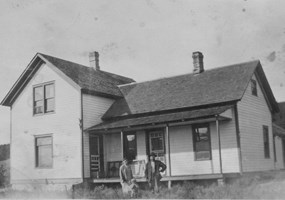|
Human occupancy of the Leelanau Peninsula began sometime after the glaciers' last retreat. Little specific information about prehistoric or early historic activity in the Port Oneida area is known. People were initially drawn to the area because of the fisheries and forests. Later, agricultural development was benefited by the longer growing season provided by the lake effect along the shoreline. Carsten Burfiend, Port Oneida's first European resident, departed Hanover, Germany in 1846 and landed in Buffalo, NY before traveling by steamship to North Manitou Island. His wife, Elizabeth, remained in Buffalo. Upon reaching the island, he built a cabin and worked as a fisherman until 1852, when the U.S. Government opened mainland Michigan to settlement. He then purchased 275 acres of land on the west side of Pyramid Point and moved his wife and small children to what later became Port Oneida. Continuing to work as a fisherman, Burfiend also ferried early settlers between the islands and mainland on his fishing boat. According to one account, one of his passengers, John E. Fisher, was the first settler on the mainland and the founder of Glen Arbor. The Burfiend family lived in a three-story log cabin on the beach until the fierce storms forced them to move their home to the bluffs above the lake. They faced extreme hardships in their early years, including the deaths of three sons from pneumonia or drowning. 
Susan Pocklington, Preserve Historic Sleeping Bear 2021 Frederick and Margaretta Werner, who were also from Hanover, Germany and were close friends and possibly related to the Burfiends joined them in September, 1855. Several other early settlers were from Hanover. By the 1860 census, the population of the Pyramid Point area was 87 people, most of them were immigrants from Hanover and Prussia. Carsten Burfiend knew that Port Oneida needed a business to bring some economic opportunity to the small struggling community and that a port off of his lakefront property could be key to a better future. When Thomas Kelderhouse arrived in Port Oneida from Albany, NY, Burfiend told Kelderhouse he wanted a dock built so that ships could purchase goods from the hardworking settlers as a source of income. Kelderhouse was already a successful businessman who owned ships carrying cargo on Lake Michigan. Burfiend proposed to sell Kelderhouse some of his lakefront property on the condition that Kelderhouse build the dock. Kelderhouse purchased the property and the dock was built by 1862. Kelderhouse then brought the business related to logging in the area to sell cordwood to the passing ships. The community of Port Oneida was named after the SS Oneida, one of the first steamships to stop at the dock. With the completion of the dock, the mainland's extensive hardwood forest was harvested. Kelderhouse continued buying land and began to process cordwood for sale to passing ships by building a sawmill near what is now the John Burfiend farm. Over the next 30 years, Port Oneida grew to include a blacksmith shop, a boarding house, general store and post office, two barns, and the Kelderhouse residence. Kelderhouse owned most of these buildings as well as nearly half of the land on Pyramid Point. In 1866, he bought a gristmill on the Crystal River from John Fisher. Lumbering drastically altered the appearance of the landscape. By the 1890's, most of the land had been logged off and most Great Lakes steamships were burning coal. Unable to compete with larger operations such as that of D.H. Day in Glen Haven, the dock and mill were sold. The loss of this industry and the death of Thomas Kelderhouse in 1884 led to the demise of the Kelderhouse fortune. By 1908, all the buildings at the original Port Oneida town site, except the Kelderhouse residence, had been abandoned. The Kelderhouse family lived in this house until 1934, when it was sold to Fred Baker. In 1944, the boarding house was torn down, and by 1952 the other buildings and apple orchard were removed. The wood was used in constructing the Baker Sheep Barn and the Burfiend pig barn. 
Alfred and Loraine (Olsen) Mason Farming in Port Oneida was marginal at best. The sandy glacial soils and unreliable water supply limited the success of most farms. Farmers grew an assortment of crops with potatoes as the primary cash crop. Grain was used to sustain small herds of dairy cattle. Most of the people were employed outside their farms, usually in seasonal jobs. From 1890 until World War II, Port Oneida was a closely-knit, modest, and quite ordinary farming community. The cooperative nature of farming was maintained through seasonal harvests and threshing, when neighbors worked together by going from farm to farm to gather and harvest the crops of each family building family and community bonds.
Learn more about agricultural change and Port Oneida's history at the Port Oneida Farms Heritage Center at the Charles and Hattie Olsen farm.
|
Last updated: July 10, 2025
